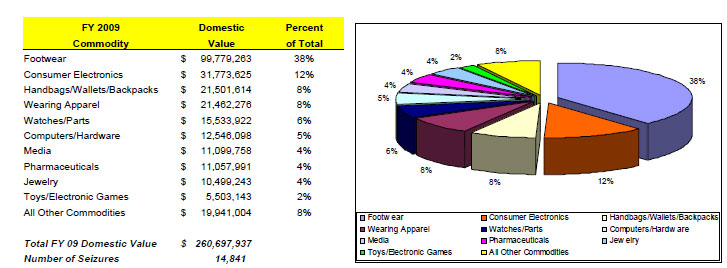SCDigest Editorial Staff
In late April, there were two separate efforts, US authorities captured hundreds of millions of counterfeit goods entering the US in a single day.
One raid was executed by a combination of federal, state and local authorities across some 30 cities, with another raid focused specifically on fakes coming in through the port of Baltimore.
The multi-city raid found and confiscated about $40 million worth of counterfeit goods, including fake Rolex watches, Coach handbags, Nike shoes, pirated DVDs and counterfeit pharmaceutical products.
The Baltimore focused raid came after a long-running investigation and confiscated goods worth some $200 million.
The $240 million in goods taken in the April raids compared with about $260 million in fake goods confiscated in all of 2009. The largest single raid last year took place in December, when officials seized about $26 million worth of fake toys, Christmas ornaments, perfume, and electronics.
Federal officials says that criminal gangs from China are behind most of the fake goods entering the US, accounting for about 80% by value of the counterfeit goods seized last year. The products most commonly counterfeiting by value come from footwear products (e.g., fake Nikes), followed by consumer electronics, luxury goods (e.g., fake Coach purses), and pharmaceutical products. (See graphic below).

Source: US Immigration and Customs Enforcement (ICE)
Of course, those numbers only reflect actual seizures of counterfeit goods. The actual numbers brought into the US and especially sold abroad are likely multiple times that figure, likely running into the billions of dollars.
The 30-city raid was dubbed operations “Spring Cleaning,” and in Port Elizabeth, NJ, officials found two containers full of some 15,000 pairs of fake Nike athletic shoes, said to be worth about $1 million dollars. Fake Nikes were found in other ports as well.
In Philadelphia, authorities nabbed 24,000 counterfeit high-end watches.
Even the US military is worried. Starting last week, the Naval Criminal Investigative Service and the Defense Criminal Investigative Service says it will begin targeting counterfeit goods that could get into the military’s own supply chain.
Meanwhile, the US General Services Administration will target fake goods in the federal civilian supply chain. Additionally, federal, state, and local officials will create more than 20 "IP theft enforcement teams" to target the traffic of fake goods nationwide, Immigration and Customs Enforcement (ICE) officials said.
New Government Report Highlights the Problem
Following on the heels of the raids, the Office of the United States Trade Representative (Ron Kirk) issued its annual report on the state of intellectual property protection across the globe. That focuses not only counterfeit goods but also outright knock-offs where existing US patents, trademarks, etc. are not enforced.
Story Continued Below
|